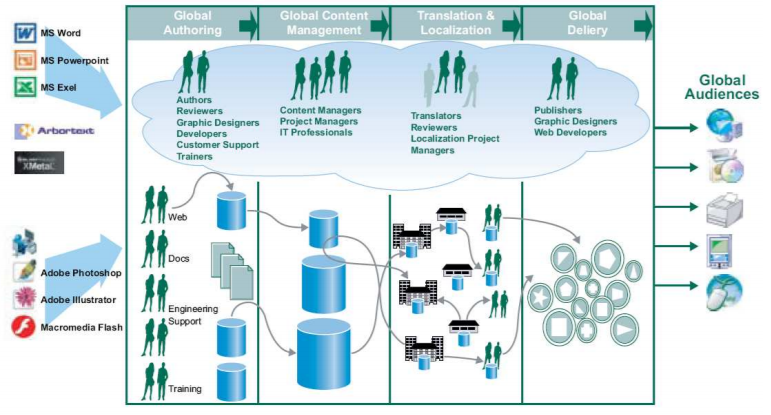Working with Translation Memories within a company¶
Introduction¶
A translation memory, or TM, is a type of database that is used in software programs designed to aid human translators. Some software programs that use translation memories are known as translation memory managers (TMM). Translation memories are typically used in conjunction with a dedicated computer assisted translation (CAT) tool such as SDL Trados ( Trados has a 90% market reach ), word processing program, terminology management systems, multilingual dictionary, or even raw machine translation output. A translation memory consists of text segments in a source language and their translations into one or more target languages. These segments can be blocks, paragraphs, sentences, or phrases. Individual words are handled by terminology bases and are not within the domain of TM.
Using translation memories¶
The program breaks the source text (the text to be translated) into segments, looks for matches between segments and the source half of previously translated source-target pairs stored in a translation memory, and presents such matching pairs as translation candidates. The translator can accept a candidate, replace it with a fresh translation, or modify it to match the source. In the last two cases, the new or modified translation goes into the database. Some translation memories systems search for 100% matches only, that is to say that they can only retrieve segments of text that match entries in the database exactly, while others employ fuzzy matching algorithms to retrieve similar segments, which are presented to the translator with differences flagged. It is important to note that typical translation memory systems only search for text in the source segment. The flexibility and robustness of the matching algorithm largely determine the performance of the translation memory, although for some applications the recall rate of exact matches can be high enough to justify the 100%-match approach. Segments where no match is found will have to be translated by the translator manually. These newly translated segments are stored in the database where they can be used for future translations as well as repetitions of that segment in the current text. Translation memories work best on texts which are highly repetitive, such as technical manuals. They are also helpful for translating incremental changes in a previously translated document, corresponding, for example, to minor changes in a new version of a user manual. Traditionally, translation memories have not been considered appropriate for literary or creative texts, for the simple reason that there is so little repetition in the language used. However, others find them of value even for non-repetitive texts, because the database resources created have value for concordance searches to determine appropriate usage of terms, for quality assurance (no empty segments), and the simplification of the review process (source and target segment are always displayed together while translators have to work with two documents in a traditional review environment). If a translation memory system is used consistently on appropriate texts over a period of time, it can save translators considerable work.
Main benefits¶
Translation memory managers are most suitable for translating technical documentation and documents containing specialized vocabularies. Their benefits include:
- Ensuring that the document is completely translated (translation memories do not accept empty target segments)
- Ensuring that the translated documents are consistent, including common definitions, phrasings and terminology. This is important when different translators are working on a single project.
- Enabling translators to translate documents in a wide variety of formats without having to own the software typically required to process these formats.
- Accelerating the overall translation process; since translation memories "remember" previously translated material, translators have to translate it only once.
- Reducing costs of long-term translation projects; for example the text of manuals, warning messages or series of documents needs to be translated only once and can be used several times.
- For large documentation projects, savings (in time or money) thanks to the use of a TM package may already be apparent even for the first translation of a new project, but normally such savings are only apparent when translating subsequent versions of a project that was translated before using translation memory.
The content lifecycle within a company¶

Practical Approach¶
Content produced by content authors will be send for translation and localization to the translation departments. The translators in translation department make use of a global translation memory to translate the document after the translated content is send to the publishers and publishing systems such as eZ Publish.
What to watch when working with translation agencies?¶
- Translation agencies should not take possession of the translation memory that they have created of a company. The translation memory is owned by the company and should help the translation agency to speed up their work. The company should keep copyright at all times about new created translations.
- Translator working on the same language need to share the same translation memory. Practically this can be archived by sharing a flat file translation memory over a shared network drive (Windows share, WebDAV, cloud storage) else you can make use a translation memory server such as Trados Live
- Work on the translation or the translation memory should get approved by a third person.
- Quoting for translation jobs. When asking for a quote from a translation agency you should hand over all content to that company together with the translation memory. After that they can properly quote that job.